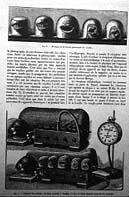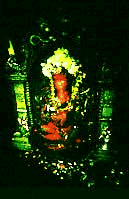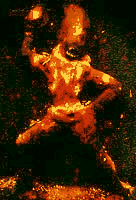
|

Turn of the century fantasies and experiments in ways to utilize machines
and, especially, electricity, to recreate a person, or a part of a person,
where widespread. This device, shown in a 1908 publication, in which a
variety of vocal sounds could be p roduced via touching one of the
valve-buttons below the mouths, is a kind of proto-interactive work, if we
take interaction to mean that the work responds, in some way, in an overt
physical manner to a physical gesture by a person who participates in its
scheme. This, of course, was not intended as an artwork. But I think it
also is a predecessor of much of today's techno-art, largely preoccupied
with demonstrating a technology. This sensibility is very familiar, of
course, in the contemporary science museum, which today is being
transformed from this earlier form of electro-mechanical interaction to
more contemporary forms of computer-driven interaction. And much of what
is called "interactive art" or techno-art borrows or derives from this
science m useum demo-aesthetic. Push a button, something happens. Put in
the money, out comes the candy bar...
 
Going back even farther in time, looking for cultural formations which are
now familiar aspects of interactive art, I was struck early on by the
essentially interactive nature of shrines, and other somehow consecrated
public places. What differs here from the contemporary interactive artwork
which relies on, as Crichton said, temptations and sources of curiosity -
here the encounter is ritualized and made into theater. It is
performative, highly prescribed and passed on from generation to
generation. In the ritualized encounter, there is quite often an actual
physical exchange which is also a symbolic exchange. One leaves something,
in a certain way, and takes something away - usually as a mark upon the
body. It is generally performed by simultaneous ac tions of touching and
looking, but here, very importantly, and in most cases completely absent
in interactive art, the voice of the participant plays an important role.
|
|

